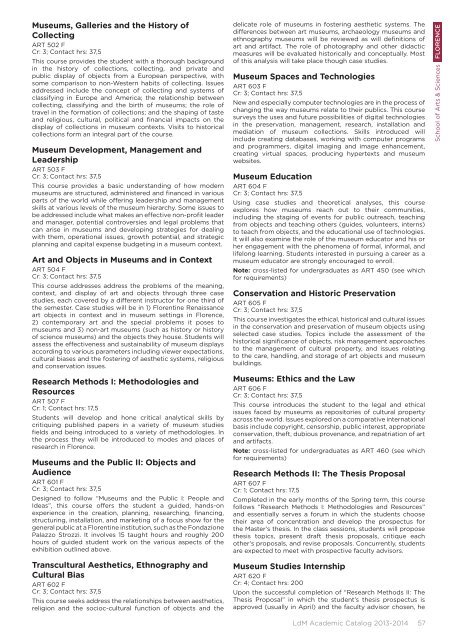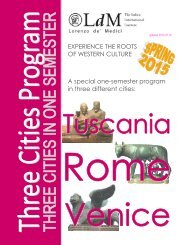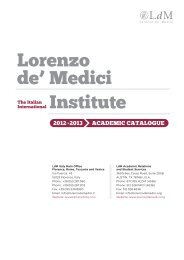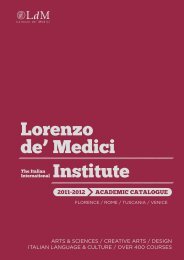aCademiC Catalog 2013-2014 - Lorenzo de Medici
aCademiC Catalog 2013-2014 - Lorenzo de Medici
aCademiC Catalog 2013-2014 - Lorenzo de Medici
You also want an ePaper? Increase the reach of your titles
YUMPU automatically turns print PDFs into web optimized ePapers that Google loves.
Museums, Galleries and the History of<br />
Collecting<br />
ART 502 F<br />
Cr: 3; Contact hrs: 37,5<br />
This course provi<strong>de</strong>s the stu<strong>de</strong>nt with a thorough background<br />
in the history of collections, collecting, and private and<br />
public display of objects from a European perspective, with<br />
some comparison to non-Western habits of collecting. Issues<br />
addressed inclu<strong>de</strong> the concept of collecting and systems of<br />
classifying in Europe and America; the relationship between<br />
collecting, classifying and the birth of museums; the role of<br />
travel in the formation of collections; and the shaping of taste<br />
and religious, cultural, political and financial impacts on the<br />
display of collections in museum contexts. Visits to historical<br />
collections form an integral part of the course.<br />
Museum Development, Management and<br />
Lea<strong>de</strong>rship<br />
ART 503 F<br />
Cr: 3; Contact hrs: 37,5<br />
This course provi<strong>de</strong>s a basic un<strong>de</strong>rstanding of how mo<strong>de</strong>rn<br />
museums are structured, administered and financed in various<br />
parts of the world while offering lea<strong>de</strong>rship and management<br />
skills at various levels of the museum hierarchy. Some issues to<br />
be addressed inclu<strong>de</strong> what makes an effective non-profit lea<strong>de</strong>r<br />
and manager, potential controversies and legal problems that<br />
can arise in museums and <strong>de</strong>veloping strategies for <strong>de</strong>aling<br />
with them, operational issues, growth potential, and strategic<br />
planning and capital expense budgeting in a museum context.<br />
Art and Objects in Museums and in Context<br />
ART 504 F<br />
Cr: 3; Contact hrs: 37,5<br />
This course addresses address the problems of the meaning,<br />
context, and display of art and objects through three case<br />
studies, each covered by a different instructor for one third of<br />
the semester. Case studies will be in 1) Florentine Renaissance<br />
art objects in context and in museum settings in Florence,<br />
2) contemporary art and the special problems it poses to<br />
museums and 3) non-art museums (such as history or history<br />
of science museums) and the objects they house. Stu<strong>de</strong>nts will<br />
assess the effectiveness and sustainability of museum displays<br />
according to various parameters including viewer expectations,<br />
cultural biases and the fostering of aesthetic systems, religious<br />
and conservation issues.<br />
Research Methods I: Methodologies and<br />
Resources<br />
ART 507 F<br />
Cr: 1; Contact hrs: 17,5<br />
Stu<strong>de</strong>nts will <strong>de</strong>velop and hone critical analytical skills by<br />
critiquing published papers in a variety of museum studies<br />
fields and being introduced to a variety of methodologies. In<br />
the process they will be introduced to mo<strong>de</strong>s and places of<br />
research in Florence.<br />
Museums and the Public II: Objects and<br />
Audience<br />
ART 601 F<br />
Cr: 3; Contact hrs: 37,5<br />
Designed to follow “Museums and the Public I: People and<br />
I<strong>de</strong>as”, this course offers the stu<strong>de</strong>nt a gui<strong>de</strong>d, hands-on<br />
experience in the creation, planning, researching, financing,<br />
structuring, installation, and marketing of a focus show for the<br />
general public at a Florentine institution, such as the Fondazione<br />
Palazzo Strozzi. It involves 15 taught hours and roughly 200<br />
hours of gui<strong>de</strong>d stu<strong>de</strong>nt work on the various aspects of the<br />
exhibition outlined above.<br />
<strong>de</strong>licate role of museums in fostering aesthetic systems. The<br />
differences between art museums, archaeology museums and<br />
ethnography museums will be reviewed as will <strong>de</strong>finitions of<br />
art and artifact. The role of photography and other didactic<br />
measures will be evaluated historically and conceptually. Most<br />
of this analysis will take place though case studies.<br />
Museum Spaces and Technologies<br />
ART 603 F<br />
Cr: 3; Contact hrs: 37,5<br />
New and especially computer technologies are in the process of<br />
changing the way museums relate to their publics. This course<br />
surveys the uses and future possibilities of digital technologies<br />
in the preservation, management, research, installation and<br />
mediation of museum collections. Skills introduced will<br />
inclu<strong>de</strong> creating databases, working with computer programs<br />
and programmers, digital imaging and image enhancement,<br />
creating virtual spaces, producing hypertexts and museum<br />
websites.<br />
Museum Education<br />
ART 604 F<br />
Cr: 3; Contact hrs: 37,5<br />
Using case studies and theoretical analyses, this course<br />
explores how museums reach out to their communities,<br />
including the staging of events for public outreach, teaching<br />
from objects and teaching others (gui<strong>de</strong>s, volunteers, interns)<br />
to teach from objects, and the educational use of technologies.<br />
It will also examine the role of the museum educator and his or<br />
her engagement with the phenomena of formal, informal, and<br />
lifelong learning. Stu<strong>de</strong>nts interested in pursuing a career as a<br />
museum educator are strongly encouraged to enroll.<br />
Note: cross-listed for un<strong>de</strong>rgraduates as ART 450 (see which<br />
for requirements)<br />
Conservation and Historic Preservation<br />
ART 605 F<br />
Cr: 3; Contact hrs: 37,5<br />
This course investigates the ethical, historical and cultural issues<br />
in the conservation and preservation of museum objects using<br />
selected case studies. Topics inclu<strong>de</strong> the assessment of the<br />
historical significance of objects, risk management approaches<br />
to the management of cultural property, and issues relating<br />
to the care, handling, and storage of art objects and museum<br />
buildings.<br />
Museums: Ethics and the Law<br />
ART 606 F<br />
Cr: 3; Contact hrs: 37,5<br />
This course introduces the stu<strong>de</strong>nt to the legal and ethical<br />
issues faced by museums as repositories of cultural property<br />
across the world. Issues explored on a comparative international<br />
basis inclu<strong>de</strong> copyright, censorship, public interest, appropriate<br />
conservation, theft, dubious provenance, and repatriation of art<br />
and artifacts.<br />
Note: cross-listed for un<strong>de</strong>rgraduates as ART 460 (see which<br />
for requirements)<br />
Research Methods II: The Thesis Proposal<br />
ART 607 F<br />
Cr: 1; Contact hrs: 17,5<br />
Completed in the early months of the Spring term, this course<br />
follows “Research Methods I: Methodologies and Resources”<br />
and essentially serves a forum in which the stu<strong>de</strong>nts choose<br />
their area of concentration and <strong>de</strong>velop the prospectus for<br />
the Master’s thesis. In the class sessions, stu<strong>de</strong>nts will propose<br />
thesis topics, present draft thesis proposals, critique each<br />
other’s proposals, and revise proposals. Concurrently, stu<strong>de</strong>nts<br />
are expected to meet with prospective faculty advisors.<br />
School of Arts & Sciences FLORENCE<br />
Transcultural Aesthetics, Ethnography and<br />
Cultural Bias<br />
ART 602 F<br />
Cr: 3; Contact hrs: 37,5<br />
This course seeks address the relationships between aesthetics,<br />
religion and the socioc-cultural function of objects and the<br />
Museum Studies Internship<br />
ART 620 F<br />
Cr: 4; Contact hrs: 200<br />
Upon the successful completion of “Research Methods II: The<br />
Thesis Proposal” in which the stu<strong>de</strong>nt’s thesis prospectus is<br />
approved (usually in April) and the faculty advisor chosen, he<br />
LdM Aca<strong>de</strong>mic <strong>Catalog</strong> <strong>2013</strong>-<strong>2014</strong><br />
57





